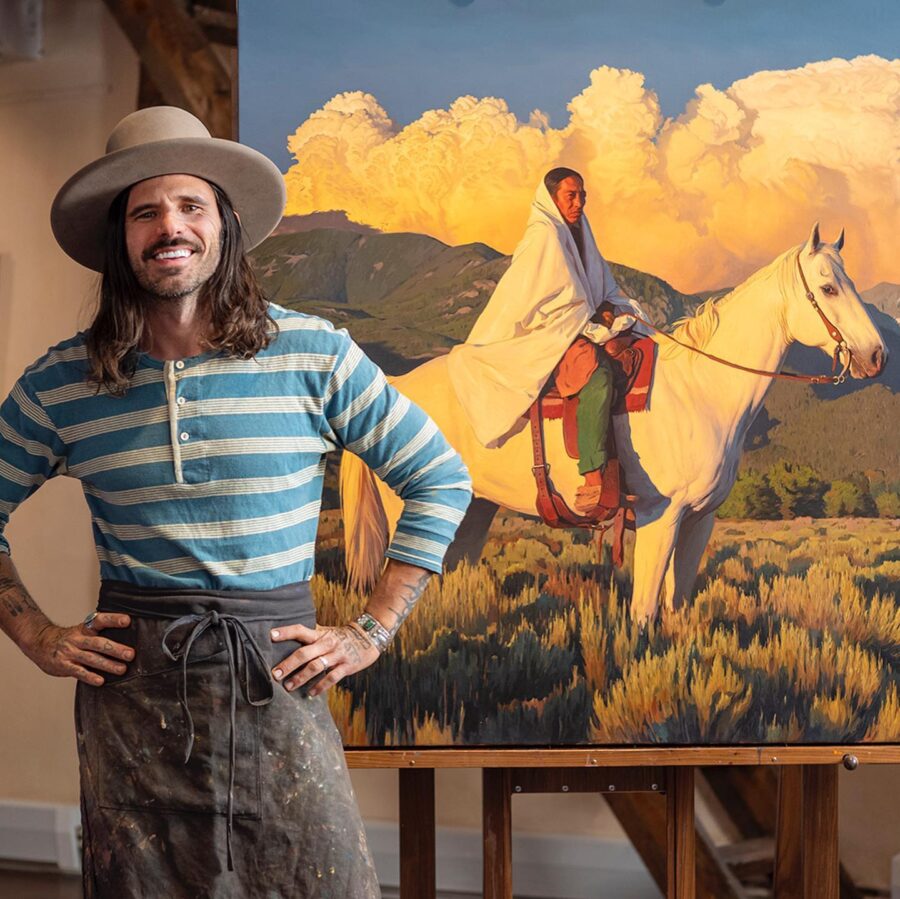Born in Fontainebleau, France, in 1977, the French-American painter Mark Maggiori has become a prominent figure in contemporary art. His work is known for its luminous realism and atmospheric depth, which he uses to depict American cowboys, Native Americans, and the landscapes of the American Southwest. Maggiori’s career is notable for the way a European artist has redefined a quintessentially American genre. His unique perspective, often referred to as an “outsider’s gaze,” is central to his appeal and has sparked critical discussions about cultural representation and the future of Western art.
Roots and Rhythms: A Painter’s Unconventional Genesis
Maggiori’s background is a mix of intellectual and artistic influences. The son of a French philosopher and journalist, he received formal training at the Académie Julian in Paris, where he was influenced by masters such as John Singer Sargent. This classical European education, combined with his later study of Western masters like N.C. Wyeth and Harvey Dunn, helped him create a unique style that blends French light and color techniques with American West themes.
A pivotal moment in his life occurred at age 15 during a road trip across the United States, which sparked a lifelong fascination with the Southwest’s landscapes and imagery. Before dedicating himself to painting, Maggiori co-founded and was the lead vocalist for the successful nu-metal band Pleymo from 1997 to 2007. His time as a music video director gave him a strong understanding of framing and composition, which is evident in his paintings that often resemble cinematic film stills.
Maggiori’s full-time painting career began in 2013-2014, following an “epiphany” inspired by Frederic Remington’s work at the National Cowboy & Western Heritage Museum. At age 36, he moved to Arizona to immerse himself in the culture and landscape, and he quickly rose through the ranks of the Western art world.
The Canvas as Frontier: Maggiori’s Dominance in the Contemporary Landscape
Maggiori’s art is defined by his signature “luminous realism,” which is characterized by meticulous detail and a deep sense of atmosphere. A key element of his work is his depiction of clouds, which are described as “layered, textural monuments” and “full-fledged characters” that add tension and narrative depth to his compositions. Maggiori sees these skies as representing “nature and the force of nature”.
His work is also heavily influenced by Western cinema, particularly the films of John Ford. His paintings are often seen as “carefully composed shots” with dramatic depth of field, freezing “the most emblematic sequences of the great westerns” onto the canvas. He uses techniques like Ford’s low-angle shots to give his cowboy subjects an iconic status. Maggiori’s art intentionally suggests an “understated movement, as if part of a larger story” , and he leaves room for viewers to interpret their own narratives.
Maggiori is a leading figure in the “New Western Art” movement, which revitalizes the genre by incorporating modern influences like animation and comic books. His creative process is highly detailed and involves extensive fieldwork, where he photographs real cowboys and Native Americans to ensure an authentic connection to his subjects. He dedicates approximately 85% of his time to mixing paint and only 15% to applying it to the canvas, reflecting his commitment to precision. His artistic philosophy is encapsulated in his statement, “For me, it’s not good when it’s finished, it’s finished when it’s good”.
His institutional recognition includes numerous awards, such as the Don B. Huntley Spirit of the West Award from the Autry Museum of the American West in both 2018 and 2019. Maggiori’s paintings have a strong commercial presence, with original works selling for over $500,000. A solo exhibition at Legacy Gallery in Scottsdale, Arizona, generated over $3 million in sales from 19 paintings. In addition to gallery sales, Maggiori holds popular limited and timed edition print “drops” twice a year, which are described as “online buying frenzies”. He uses social media to connect with his large following and announces these releases to hundreds of thousands of followers. This strategic use of online platforms and disruptive exhibition models, such as the self-funded “Far West” group show in New York City, has expanded the audience for Western art, attracting younger and new collectors.
The Myth and the Mirror: Critical Dialogues on Maggiori’s Art
Maggiori’s unique position has led to him being called a “brilliant impostor,” as he is a Frenchman successfully re-presenting American mythology to Americans. His outsider status allows him to approach the cowboy as a “pure symbol” rather than a “problematic historical figure”. Some critics argue that this detachment helps him avoid the “pitfalls of kitsch” often associated with Western art.
Despite his acclaim, some within the art community criticize his paintings for being “different versions of the same thing,” suggesting a lack of thematic variation. Others have described his work as “artificial and boring” or “corporate art”. This highlights the tension between artistic exploration and the commercial demands that can influence an artist’s output.
Sociologically, Maggiori’s art can be seen as a “collective representation” that offers an “idealized image” for a contemporary America experiencing an identity crisis. His exhibitions and print “drops” function as “collective rituals” that reinforce a shared identity among his audience. His work, with its dramatic skies and themes of man versus nature, also resonates with Frederick Jackson Turner’s “Frontier Thesis”.
A significant ethical discussion surrounds Maggiori’s depictions of Native Americans. Dakota Hoska, Assistant Curator of Native American Art at the Denver Art Museum, argues that such romanticized portrayals by non-Native artists are a form of “identity theft” that flatten the Native American experience and “leav[e] us frozen in time”. Maggiori, for his part, has expressed a commitment to authenticity and direct engagement, stating he wanted to meet Native Americans and “get into” their culture before painting them. He works with specific models from the Taos Pueblo community and established the Taos Pueblo Art Education Fund in 2021 to support local art programs.
Beyond the Sunset: The Future Trajectory of Western Art
Maggiori’s influence on contemporary painting and the Western art market continues to grow. Brad Richardson of Legacy Galleries believes his art “will stand the test of time”. His disruptive exhibition strategies, such as the self-funded “Far West” group show, are reshaping how Western art is consumed. The show’s tickets for opening night sold out in seven minutes, demonstrating the immense demand for his work.
Maggiori has expressed interest in painting historical scenes from 1800-1900, which suggests a potential for thematic expansion. His focus on the universal appeal of the cowboy and the romanticized relationship with nature provides enduring subject matter that can be reinterpreted over time. His commercial success aligns with global art market trends, including the rising demand for contemporary representational art and the shift towards online sales. His strategy of offering limited-edition prints caters to millennial and Gen Z collectors who prefer more accessible price points.
A New Chapter for the Western Canvas
Mark Maggiori is a unique and influential artist who has redefined contemporary Western painting by bridging diverse cultural and artistic backgrounds. His journey from French academic training and a career in nu-metal to becoming a leader in American Western art highlights his versatility and visionary approach. He is not only a painter but a cultural phenomenon whose work both reflects and shapes perceptions of the American West. Through his distinctive perspective and innovative methods, Maggiori ensures that Western art remains a vibrant and relevant narrative in the global cultural consciousness.









